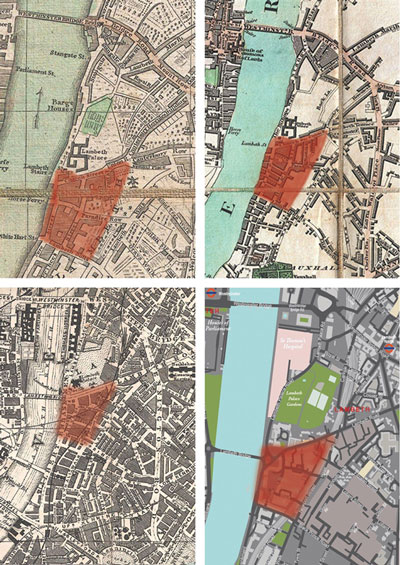A name defines an area. Recorded in 1062 as ‘Lambehitha’ and then in 1255 as ‘Lambeth’, the name which now refers to the whole borough derives from Old English and literally translates as the ‘landing place for lambs’. It may be a reference to there having been a harbour, used to receive or send out shipments of lambs, or it could simply refer to the actual loam (or mud) of a harbour.
The Manor of Lambeth (now Lambeth Palace) is recorded as being under the ownership of the Archbishop of Canterbury from at least 1190. The Archbishops led the development of much of the Manor, with Archbishop Hubert Walter creating the residence of Lambeth Palace in 1197. The Palace was the site of two important 13th-century international treaties: the Treaty of Lambeth 1212; and the Treaty of Lambeth 1217.
Edward the Black Prince lived in north Lambeth in the 14th century, in an estate that incorporated most of the land not belonging to the Archbishops, and which included Kennington. Black Prince Road was named after him, having previously been known as Lambeth Butts.
Land belonging to the Black Prince was also the site of the principal medieval London residence of the Dukes of Norfolk. However, by 1680, they had sold their very large house and it became the base of a pottery manufacturer, creating some of the first examples of English delftware in the country.
Until the 18th century, north Lambeth was still partly rural in nature, being outside the boundaries of central London. It experienced growth in the form of taverns and entertainment venues, such as theatres and bear pits. These needed to be outside the control of city regulations in order to operate. The subsequent growth in road and marine transport, along with the development of industry in the wake of the Industrial Revolution brought great change to the area.
Between 1801 and 1831 the population of Lambeth trebled and in ten years alone, between 1831 and 1841, it increased from 87,856 to 105,883. Furthermore in the 1840s the railway came to Lambeth. The London and South Western Railway line was extended from its original station at Nine Elms to a new terminus at Waterloo via a new Nine Elms to Waterloo Viaduct.
For many years Lambeth Walk and Lambeth High Street were the two principal commercial streets of Lambeth Village, but today only the former retains local commercial activity. Lambeth Walk had a market, which by 1938 had 159 shops, including 11 butchers. However the street and surrounding roads, like most of Lambeth, were extensively damaged during the Second World War. This included the complete destruction of the area’s Victorian swimming-baths when a V2 rocket hit the street in 1945, causing the deaths of 37 people.
Many of the street names in Lambeth Village are reminders of the area’s history. Old Paradise Street reminds us of its 17th-century fields, Walnut Tree Walk its market gardens, Sail Street of the mills that stood there for many years, and Beaufoy Technical School of the Ragged School benefactor, Henry Beaufoy. The High Street leading to St Mary’s Church reminds us that, not only was Lambeth Village orientated to the parish church, but also to the centre of the Church of England, Lambeth Palace.
Below are maps outlining the Lambeth Village area.

Here are some notes of historical interest relating to St Mary’s of Lambeth, now the Garden Museum:
Captain Bligh (1754-1817) of the ‘The Bounty’ is buried in St Mary’s of Lambeth.
John Tradescant (c.1570-1638) is buried at St Mary’s of Lambeth. He is one of the most captivating characters in the story of gardens in Britain. Born in obscurity, the first record of his existence is a letter written on a journey to Holland to buy plants for the 1st Earl of Salisbury’s garden at Hatfield House. Later he became the gardener to Henrietta Maria, ‘the rose and lily queen’ of Charles I.
Tradescant exchanged specimens with the great botanists of his day, and was known for his adventures. In order to collect new plants he sailed to both the Arctic, in 1618, and joined an expedition to Algeria to fight the Barbary pirates in 1620. However, in 1629 he came to live in Lambeth, close to where the Museum now stands. Here he planted a botanical garden. He also set up one of the first museums in Britain to be open to the public. The ‘Ark’, a large house, displayed his collection of natural history, art and ethnography.
His son, John Tradescant the Younger (1608-1662), who was married at St Mary’s, travelled to America to collect plant specimens and succeeded his father as the Royal Gardener. At his death, his widow commissioned a magnificent tomb in the churchyard of St Mary’s, carved with scenes of their life and work.
The Tradescant collection, which was added to significantly, was given to the University of Oxford by Elias Ashmole, a Lambeth neighbour. It was combined with an older University collection to become the Ashmolean Museum, which opened in 1683.
